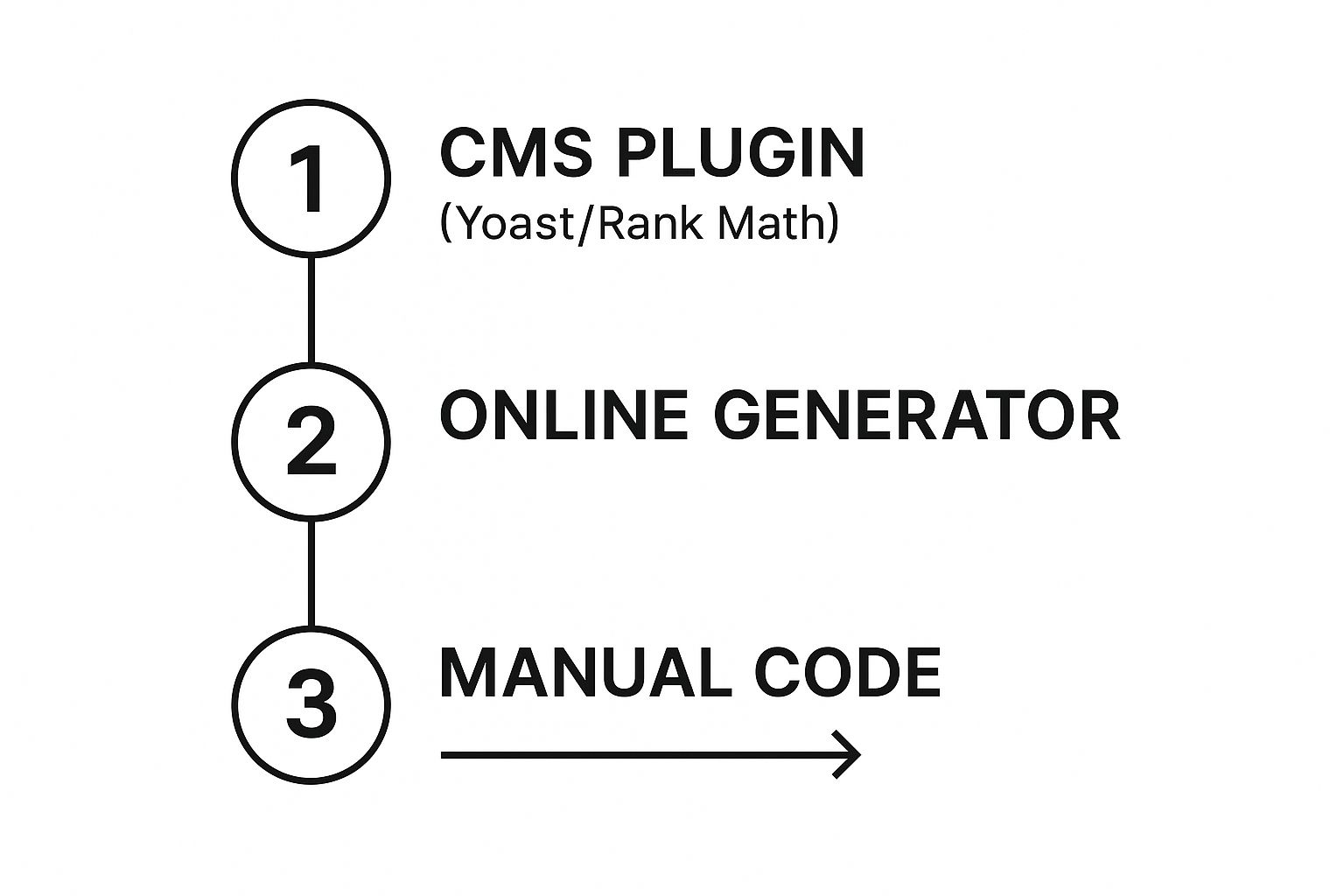Creating an XML sitemap is one of those core SEO tasks that sounds way more technical than it actually is. At its heart, you're just generating a simple file that lists all your important URLs. This file acts as a roadmap for search engines like Google, helping them discover and crawl your site much more efficiently. You can use anything from automated CMS plugins like Yoast SEO to online generators to get the job done quickly.
Why an XML Sitemap Is Your SEO Game-Changer
Before we jump into the "how," it's crucial to understand why this simple file is so important. Think of your website as a new city and Google's crawlers as explorers. Without a map, they might miss hidden alleyways or entire neighborhoods. An XML sitemap is that map—it’s a direct line of communication you provide to search engines.
It's a comprehensive list of all the URLs on your site that you want them to find and index. This ensures that even pages without a ton of internal links—like a brand-new blog post or a recently added product page—get discovered quickly.
Accelerating Discovery and Indexing
The biggest benefit is speed. When you publish new content or update an existing page, an updated sitemap signals this change to search engines. This prompts them to crawl and index your content faster, meaning it can start showing up in search results sooner. For businesses in competitive markets like Kansas City, getting your new service page or blog post indexed before a competitor can make a real difference.
On top of that, a well-organized sitemap helps search engines understand your site's architecture. It perfectly complements the work you do when you plan your website structure, reinforcing the hierarchy and importance of your pages.
A sitemap isn’t just a list of links; it’s a declaration of your most important content. It tells search engines, "Hey, pay attention to these pages first," ensuring your crawling budget is spent on the pages that actually matter for your business.
The Technical Foundation of Visibility
While the concept is simple, there are some technical guidelines to follow. Google's official recommendations state that an XML sitemap should contain no more than 50,000 URLs and be under 50 MB uncompressed. If your site is bigger than that, you'll need to create what’s called a sitemap index file, which is basically a sitemap that links to multiple smaller sitemaps.
Here's an example straight from Google that illustrates a basic XML sitemap structure.

This screenshot shows the essential tags, including <loc> for the URL itself and <lastmod> for the last modification date, giving search engines valuable context. It might look like just another file, but it's a fundamental tool for SEO success.
Choosing the Right Sitemap Creation Method
Deciding how to create your XML sitemap isn't a one-size-fits-all deal. The best approach really hinges on your website's tech stack and how complex it is. There are a few different paths you can take, each with its own pros and cons, so let’s break them down to find the right fit for you.
For most people, the easiest and most reliable route is to lean on your Content Management System (CMS). Platforms like WordPress, Shopify, or HubSpot either have sitemap features baked right in or play nicely with powerful plugins that handle it for you. This is the way to go for the vast majority of websites because it puts everything on autopilot.
If you're running a WordPress site, for example, using an SEO plugin like Yoast SEO or Rank Math is pretty much standard practice. These tools don't just generate your sitemap; they automatically update it every time you publish a new page or post. It's a true "set it and forget it" solution that ensures your sitemap is always up-to-date without you lifting a finger.
Automating with CMS Plugins
Let’s be honest, for any dynamic website—like an e-commerce store with a constantly changing product lineup or a blog that’s updated weekly—automation is non-negotiable. Trying to manually update a sitemap for hundreds, let alone thousands, of pages would be an absolute nightmare.
Using a CMS plugin isn't just about making your life easier; it's about accuracy. These tools are built to dynamically add new pages and remove deleted ones, guaranteeing that search engines always have a current map of your most important, indexable content.
This infographic lays out the common ways to get a sitemap made, from automated plugins to the more hands-on methods.

As you can see, the CMS plugin path is the most direct and automated, which is why it’s the top choice for most modern websites.
Online Generators and Manual Creation
But what if you aren't using a CMS? If you have a small, static website—think a local plumber with a simple 10-page site built in plain HTML—a free online sitemap generator is a perfect fit. Tools like XML-Sitemaps.com can crawl your site and spit out a ready-to-go sitemap.xml file in just a few minutes.
The process is incredibly straightforward:
- You pop in your website's homepage URL (e.g.,
https://mykansasplumbing.com). - The tool crawls all your public pages, like
/about,/services, and/contact. - It generates the XML file for you to download.
- You then upload that file to your site's root directory using FTP.
The only real catch is that this is a completely manual process. Every single time you add or remove a page, you have to remember to do it all over again to keep your sitemap accurate. This approach is only really practical for sites that almost never change. This process of uploading files is a critical step, much like the final technical checks you’ll run when you learn how to launch a new website for the first time.
Lastly, there's the hardcore manual approach: writing the XML code by hand. This gives you total control but is only really suitable for developers or people with tiny, simple sites who are comfortable with XML syntax. Given how efficient the other methods are, this is rarely the recommended path.
Comparing XML Sitemap Creation Methods
To help you decide, let's look at the most common methods for generating an XML sitemap side-by-side. This table breaks down their pros, cons, and who they're best suited for, giving you a clear picture of which path makes the most sense for your specific situation.
| Method | Best For | Pros | Cons |
|---|---|---|---|
| CMS Plugin | Dynamic sites (WordPress, Shopify, etc.) | Fully automated; always up-to-date; easy for non-developers. | Dependent on the CMS and plugin functionality. |
| Online Generator | Small, static HTML/CSS sites | Quick and easy for one-time generation; no coding required. | 100% manual; requires re-generation and re-upload for every site change. |
| Manual Coding | Developers or technical SEOs with very small sites | Complete control over every detail and parameter. | Time-consuming; high risk of syntax errors; impractical for large sites. |
Ultimately, choosing the right tool comes down to balancing automation with control. For nearly everyone, a CMS plugin offers the perfect mix, handling the technical details so you can focus on creating great content.
Generating Your Sitemap with Popular Tools
Alright, let's move from theory to action and get our hands dirty generating your sitemap. The good news? You absolutely do not need to be a coding wizard to get this done. Modern tools have made this process incredibly straightforward, whether you're running a popular CMS like WordPress or a simple static HTML site.
The core idea is to let the software do the heavy lifting for you. For smaller sites, a free online generator like XML-Sitemaps.com can crawl up to 500 pages and give you a file in minutes. For bigger, more complex sites, this is where the automation of a good CMS plugin really shines. For a deeper look at the whole process, you can find more details in this website sitemap creation guide.
Using an SEO Plugin on WordPress
For the millions of us using WordPress, leaning on a solid SEO plugin is by far the most efficient route. Powerhouse tools like Yoast SEO or Rank Math have sitemap generation baked right in, and it’s almost always turned on by default.
With Yoast SEO, for example, creating your sitemap is literally as easy as flipping a switch. You just head over to Yoast SEO > Settings > Site features in your WordPress dashboard and make sure the "XML sitemaps" toggle is on. That's it. The plugin handles the rest, automatically creating and maintaining your sitemap as your site evolves.
Here's what that setting looks like inside the Yoast dashboard.

This simple toggle kicks off a process that generates a main sitemap index file, which then links out to individual sitemaps for your posts, pages, and any other content types you have.
Once it's enabled, you can almost always find your sitemap by just adding /sitemap_index.xml to the end of your domain (e.g., yourkansascitybusiness.com/sitemap_index.xml). The real power here is the set-it-and-forget-it automation. Every time you publish a new blog post or add a new page, it gets added to the sitemap instantly, with zero extra work from you.
Leveraging Online Sitemap Generators
But what if your site isn't on WordPress? For static HTML sites or those built on less common platforms, online sitemap generators are your best friend. These tools crawl your website just like a search engine bot would, starting from your homepage and following all the links to discover every public page.
Let's walk through a quick scenario using a tool like XML-Sitemaps.com:
- Plug in your domain. Start by dropping your full website URL into the main field.
- Check the settings. Before you hit go, you can usually configure a few parameters, but the default options are typically fine for most smaller sites.
- Let it crawl. The tool will start zipping through your site, page by page. For a site with a few hundred pages, this usually takes less than a minute.
- Download your file. Once it's done, you'll get a
sitemap.xmlfile to download to your computer.
After you have the file, you'll need to upload it to the root directory of your website. You can do this with an FTP client like FileZilla or through your hosting provider's file manager. The one major downside here is the lack of automation—every time you add a new page, you have to remember to run this process all over again.
No matter which tool you use, the goal is a clean, focused sitemap. Only include your final, canonical URLs. Be sure to exclude pages that offer no value to searchers, like "thank you" pages, internal search results, or private admin areas.
By picking the right tool for your platform, you can create a highly effective sitemap that gives search engines the exact roadmap they need. Whether you go with the automated convenience of a plugin or the quick simplicity of an online generator, you're now set up for success.
Submitting Your Sitemap to Search Engines
Right, you’ve put in the work to generate and validate your XML sitemap. That’s a huge step, but the job’s not quite done. A sitemap sitting on your server is like a map left in a glove box—it’s useless until you hand it over to the person who needs it.
This final step is all about formally delivering that map to the major search engines. It’s a direct and clear signal that says, "Hey Google, hey Bing, I've got a fresh roadmap of my most important content. Come take a look." This simple action can dramatically speed up how quickly they discover your new pages and ensure your entire site gets the attention it deserves.
Getting Your Sitemap to Google Search Console
Google Search Console (GSC) is mission control for your site's performance in Google search. Submitting your sitemap here is a non-negotiable task, but thankfully, it’s a quick one.
- First, log in to your Google Search Console property.
- In the left-hand menu, look under the "Indexing" section and click on "Sitemaps."
- You'll see a field at the top that says "Add a new sitemap." You don't need to paste the entire URL. Just type in the end of the URL where the file lives—usually something like
sitemap.xmlorsitemap_index.xml. - Hit that "Submit" button.
Once you’ve submitted it, GSC will show its status. It might say "Processing" for a bit, but what you’re looking for is a green "Success" status. This is the confirmation that Google has received your map loud and clear.
Don't Forget Bing Webmaster Tools
While Google gets all the headlines, ignoring Bing is a missed opportunity. Submitting your sitemap to Bing Webmaster Tools is just as important and equally straightforward.
- Log in to your Bing Webmaster Tools account and choose your website.
- Find "Sitemaps" in the left sidebar.
- Click the "Submit sitemap" button, which is usually in the top right. Here, you’ll paste the full sitemap URL (e.g.,
https://yourdomain.com/sitemap.xml).
Just like with GSC, Bing will give you a status update. A "Success" message confirms that Bing has been able to access and read your sitemap, putting its crawlers on the right track.
Making Sense of Sitemap Statuses and Errors
Submitting the file is just step one; now you need to keep an eye on the sitemaps report in both GSC and Bing. The status message tells you everything you need to know about the health of your submission.
A "Success" status doesn't guarantee every URL will be indexed. It just means the file itself was read correctly. Indexing still depends on a ton of other factors, like content quality and overall site health.
Here’s a quick rundown of what you might see and what to do about it:
| Status | Meaning | Action Required |
|---|---|---|
| Success | The search engine downloaded and processed your sitemap without a hitch. | None. Just keep an eye on it periodically. |
| Couldn't fetch | The crawler tried to access your sitemap file but failed. | Double-check your URL for typos. Make sure the file actually exists and isn't being blocked by your robots.txt file. |
| Errors | The sitemap was fetched, but it contains formatting mistakes or invalid URLs. | Click into the error report for specifics. Use an online validator to pinpoint the syntax problem, fix it, and resubmit the sitemap. |
If you're dealing with stubborn errors and finding that your website is not showing up on Google search, the problem might be deeper than just a faulty sitemap file. This could be a sign of more significant technical SEO issues that are preventing search engines from crawling and indexing your site correctly.
Sitemap Best Practices and Mistakes to Avoid
Just having an XML sitemap is table stakes. If you really want it to work for you, you’ve got to move beyond the basics and start treating it like the powerful SEO asset it can be. This means your sitemap isn't some file you generate once and forget about; it’s a living document that needs to perfectly reflect your site's most important content.
The core idea is to keep your sitemap lean and mean. It should only ever contain your most valuable, indexable, canonical URLs. Think of it as your website's highlight reel, not the entire raw footage.
Keeping Your Sitemap Clean and Current
One of the most common traps people fall into is a "set it and forget it" mentality. Your website is always changing, and your sitemap has to keep up. A stale sitemap that lists deleted pages, old URLs, or redirected links sends confusing signals to search engines and flat-out wastes their crawl budget.
This is especially true after a big site update or a complete redesign. I’ve seen it happen too many times—a team launches a beautiful new site but forgets to generate and resubmit a fresh sitemap. It’s a critical error that can leave their best new content sitting undiscovered for weeks.
Your XML sitemap should be a perfect mirror of the pages you want Google to index. Any discrepancy—like including redirected URLs or pages blocked by
robots.txt—creates contradictions that can hinder crawling and indexing efficiency.
Avoiding Common Sitemap Pitfalls
Even seasoned pros can make simple mistakes that water down a sitemap's effectiveness. Bloating your sitemap with low-value pages is a classic one. Pages like internal search results, tag archives, or expired promotions simply don't belong here; they dilute the importance of your core content and make it harder for crawlers to find what really matters.
Here are a few critical mistakes to steer clear of:
- Including Non-Canonical URLs: Always, always make sure only the definitive, canonical version of a URL is in the sitemap. Including duplicates or variations with tracking parameters just creates indexing confusion.
- Listing Redirected Pages: Sitemaps should only list final destination URLs—the ones that return a 200 OK status code. Including 301 or 302 redirects forces crawlers to take an extra, unnecessary step. It’s just inefficient.
- Forgetting
robots.txt: Yourrobots.txtfile and sitemap must work in harmony. Never include a URL in your sitemap that you are simultaneously blocking with aDisallowdirective inrobots.txt. That’s like inviting someone to a party but locking the front door.

Getting these elements right ensures search engines can crawl your site as efficiently as possible, which can even have a positive knock-on effect on your server load. For a deeper dive into site performance, check out our guide on how to improve website loading speed. By mastering these best practices, you ensure your sitemap is a clean, precise tool that actively helps your SEO efforts instead of quietly holding them back.
Got Questions About XML Sitemaps?
It's completely normal for questions to pop up when you're dealing with the more technical side of SEO. Let's clear up some of the most common ones I hear about XML sitemaps.
How Often Should I Update My XML Sitemap?
This really comes down to how often your site changes. If you're running a dynamic site like a blog or an e-commerce store where you're constantly adding new products or posts, your sitemap should update automatically. Most modern CMS plugins and platforms handle this for you, so it’s pretty much a "set it and forget it" task.
But for a more static business website, you only need to regenerate and resubmit your sitemap when you add, remove, or make a significant change to a URL.
What Is the Difference Between HTML and XML Sitemaps?
This is a crucial distinction that trips a lot of people up. They sound similar, but they serve completely different audiences.
An HTML sitemap is built for your human visitors. It's a navigational page that helps people get a bird's-eye view of your site and find content easily.
An XML sitemap, on the other hand, is created exclusively for search engine crawlers. It’s a technical file—not meant for human eyes—that gives bots a clean, organized list of all the URLs you want them to crawl and index.
What Do I Do if Google Reports an Error?
First off, don't panic. This happens. The first step is to check the specific error message inside Google Search Console. It will usually point you right to the problem.
Common issues I see all the time include URLs that are accidentally blocked by your robots.txt file, funky URL formatting, or a server issue that’s preventing Google from accessing the file. Use a free online XML validator to check for any syntax errors, fix the problem, and then simply resubmit the sitemap.
This is also a good time to check your analytics to see how these issues might be impacting your numbers—a key part of understanding how to track website traffic and connecting technical health to real-world performance.
Remember, a clean, focused sitemap is always more effective. Your XML sitemap should only include pages you want search engines to discover and index. Exclude non-canonical URLs, "thank you" pages, internal search results, and any thin or low-value content.
At Website Services-Kansas City, we specialize in building powerful SEO foundations for businesses. If you need a professionally optimized website that gets results, we're here to help. Visit our website to learn more about our services.